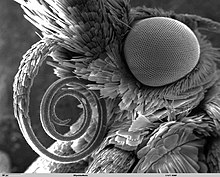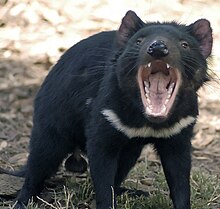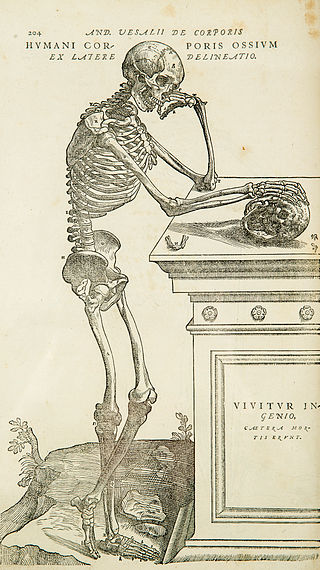
Anatomy is the branch of biology concerned with the study of the structure of organisms and their parts. Anatomy is a branch of natural science that deals with the structural organization of living things. It is an old science, having its beginnings in prehistoric times. Anatomy is inherently tied to developmental biology, embryology, comparative anatomy, evolutionary biology, and phylogeny, as these are the processes by which anatomy is generated, both over immediate and long-term timescales. Anatomy and physiology, which study the structure and function of organisms and their parts respectively, make a natural pair of related disciplines, and are often studied together. Human anatomy is one of the essential basic sciences that are applied in medicine.

An echinoderm is any deuterostomal animal of the phylum Echinodermata, which includes starfish, brittle stars, sea urchins, sand dollars and sea cucumbers, as well as the sessile sea lilies or "stone lilies". While bilaterally symmetrical as larvae, as adults echinoderms are recognisable by their usually five-pointed radial symmetry, and are found on the sea bed at every ocean depth from the intertidal zone to the abyssal zone. The phylum contains about 7,000 living species, making it the second-largest group of deuterostomes after the chordates, as well as the largest marine-only phylum. The first definitive echinoderms appeared near the start of the Cambrian.
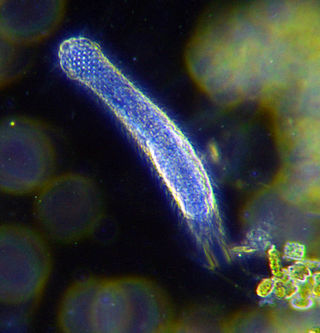
The gastrotrichs, commonly referred to as hairybellies or hairybacks, are a group of microscopic (0.06–3.0 mm), cylindrical, acoelomate animals, and are widely distributed and abundant in freshwater and marine environments. They are mostly benthic and live within the periphyton, the layer of tiny organisms and detritus that is found on the seabed and the beds of other water bodies. The majority live on and between particles of sediment or on other submerged surfaces, but a few species are terrestrial and live on land in the film of water surrounding grains of soil. Gastrotrichs are divided into two orders, the Macrodasyida which are marine, and the Chaetonotida, some of which are marine and some freshwater. Nearly 800 species of gastrotrich have been described.
Gnathostomulids, or jaw worms, are a small phylum of nearly microscopic marine animals. They inhabit sand and mud beneath shallow coastal waters and can survive in relatively anoxic environments. They were first recognised and described in 1956.

Nemertea is a phylum of animals also known as ribbon worms or proboscis worms, consisting of 1300 known species. Most ribbon worms are very slim, usually only a few millimeters wide, although a few have relatively short but wide bodies. Many have patterns of yellow, orange, red and green coloration. The foregut, stomach and intestine run a little below the midline of the body, the anus is at the tip of the tail, and the mouth is under the front. A little above the gut is the rhynchocoel, a cavity which mostly runs above the midline and ends a little short of the rear of the body. All species have a proboscis which lies in the rhynchocoel when inactive but everts to emerge just above the mouth to capture the animal's prey with venom. A highly extensible muscle in the back of the rhynchocoel pulls the proboscis in when an attack ends. A few species with stubby bodies filter feed and have suckers at the front and back ends, with which they attach to a host.

Mussidae is a family of stony coral in the order Scleractinia. Following a taxonomic revision in 2012, the family is now restricted to species found in the Atlantic Ocean, with Pacific species transferred to the new family Lobophylliidae. Many species are referred to as brain coral because their generally spheroid form and grooved surface resembles the convolutions of a brain.
A molluscivore is a carnivorous animal that specialises in feeding on molluscs such as gastropods, bivalves, brachiopods and cephalopods. Known molluscivores include numerous predatory molluscs,, arthropods such as crabs and firefly larvae, and, vertebrates such as fish, birds and mammals. Molluscivory is performed in a variety ways with some animals highly adapted to this method of feeding behaviour. A similar behaviour, durophagy, describes the feeding of animals that consume hard-shelled or exoskeleton bearing organisms, such as corals, shelled molluscs, or crabs.
Evisceration is a method of autotomy involving the ejection of internal organs used by animals as a defensive strategy. Sea cucumbers (Holothuroidea) eject parts of the gut in order to scare and defend against potential predators such as crabs and fish. The organs are regenerated in a few days by cells in the interior of the sea cucumber.

Phoronids are a small phylum of marine animals that filter-feed with a lophophore, and build upright tubes of chitin to support and protect their soft bodies. They live in most of the oceans and seas, including the Arctic Ocean but excluding the Antarctic Ocean, and between the intertidal zone and about 400 meters down. Most adult phoronids are 2 cm long and about 1.5 mm wide, although the largest are 50 cm long.
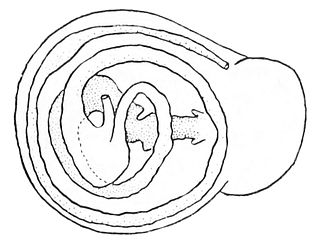
The digestive system of gastropods has evolved to suit almost every kind of diet and feeding behavior. Gastropods as the largest taxonomic class of the mollusca are very diverse: the group includes carnivores, herbivores, scavengers, filter feeders, and even parasites.

Cuvierian tubules are clusters of fine tubes located at the base of the respiratory tree in some sea cucumbers in the genera Bohadschia, Holothuria and Pearsonothuria, all of which are included in the family Holothuriidae. The tubules can be discharged through the anus when the sea cucumber is stressed. They lengthen when they come into contact with seawater and become adhesive when they encounter objects, functioning as a form of defense against predators or sources of danger. They are named after the French zoologist Georges Cuvier, who first described them.
Perophora viridis, the honeysuckle tunicate, is a species of colonial sea squirt in the genus Perophora found in the tropical western Atlantic Ocean.

Oikopleura cophocerca is a species of small pelagic tunicate found in the surface waters of most of the world's oceans. It superficially resembles a tadpole and is surrounded by a transparent mucus net known as a "house".

Branchiobdellida is an order of freshwater leech-like clitellates that are obligate ectosymbionts or ectoparasites, mostly of astacoidean crayfish. They are found in the Northern Hemisphere and have a holarctic distribution in East Asia, the Euro-Mediterranean region and North and Central America, with the greatest species diversity being in North and Central America.

The annelids, also known as the segmented worms, are a large phylum, with over 22,000 extant species including ragworms, earthworms, and leeches. The species exist in and have adapted to various ecologies – some in marine environments as distinct as tidal zones and hydrothermal vents, others in fresh water, and yet others in moist terrestrial environments.

In zoology, a mesentery is a membrane inside the body cavity of an animal. The term identifies different structures in different phyla: in vertebrates it is a double fold of the peritoneum enclosing the intestines; in other organisms it forms complete or incomplete partitions of the body cavity, whether that is the coelom or, as in the Anthozoa, the gastrovascular cavity.

Polycarpa pomaria is a species of tunicate or sea squirt in the family Styelidae. It is native to the northeastern Atlantic Ocean where it lives on the seabed at depths down to about 450 metres (1,500 ft).

Polystoma integerrimum is a flatworm (platyhelminth) from the class Monogenea found in amphibians in Asia and Europe. It is an endoparasite of frogs and toads and has an unusual life cycle which synchronises with that of its host.

Leodia sexiesperforata, commonly known as the six-holed keyhole urchin, is a species of sand dollar, in the echinoderm order Clypeasteroida. It is native to tropical and sub-tropical parts of the western Atlantic Ocean where it buries itself in soft sediment in shallow seas.

Calma glaucoides is a species of marine nudibranch in the family Calmidae. The holotype was described by Alder & Hancock in 1854 from Herm in the Channel Islands, but the nudibranch has since been detected in other parts of the British Isles. It was originally given the name Eolis glaucoides but has since been transferred to the genus Calma. It is an egg predator, feeding on the eggs of fish and cephalopods.


